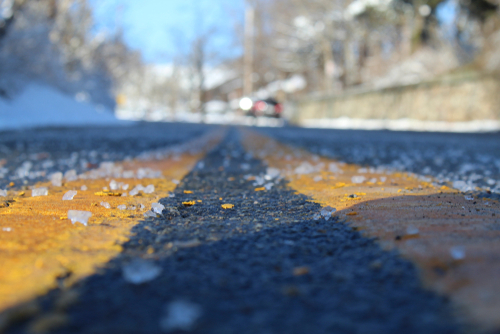
Winter has come in like a lion for much of the Midwest. December was plagued by endless Arctic Blasts and slippery road conditions. Winter weather probably has you yearning for summertime, and the same can be said for your vehicle. Unless you take special care, road salt will wreak havoc on your vehicle’s body, especially its undercarriage.
A salt and sand mixture is frequently spread over roads before or after a snow storm hits. Salt lowers water’s freezing point, causing any ice already formed to melt even though the air temperature remains well below freezing. Sand then helps keep the salt in place, adding traction to slick roads. This important mixture is essential during winter months, and helps us travel safely. However, letting sand eat away at your vehicle’s exterior can be costly. If you’re one of the many Midwesterners who must brave salt-covered streets, you’ll want to follow a few tips as we enter snowy winter and springtime months.
Some Common Misconceptions
While subzero temperatures are difficult to bear, it’s actually middle temperatures from roughly 5 degrees to 35 degrees that really make a mess. Rust forms when moisture and oxygen combine on metal, and salt accelerates that process because it corrodes. The same concept applies to parking inside. Coming in and out of a warm environment is good for the motor and transmission, but the same cannot be said for your vehicle’s body. It’s nice to keep your vehicle in a warm garage, but it can actually do more damage to its undercarriage. If you know that the weather forecast predicts a deep arctic plunge, it’s a good idea to get your car washed beforehand.
A Little TLC Goes a Long Way
We understand that you’re probably not going to park your car outside to avoid the warm garage, or never drive during mid-temperatures. Hey, we feel the same way! However, you can take steps to extend the lifetime of your vehicle by keeping it as clean as possible during cold weather. It’s important to take your vehicle through a car wash as often as possible, preferably once a week. Many car washes in the Midwest offer steam cleaning and undercarriage cleaning in addition to regular washing, so make sure to find a location that provides these services.
It’s also important to have your vehicle re-waxed and sealed when you have it washed. The biggest threat salt poses to a vehicle is rust, which is accelerated by repeated exposure to salt. Rust in certain areas can create several problems, from hydraulic brake system leaks to subframe damage. And since the majority of a vehicle’s underbody is wide open, most salt damage occurs underneath the car and is difficult to spot. That’s why frequent undercarriage washes and a fresh coat of wax will go a long way in maintaining your vehicle. A thorough car wash will remove salt from your vehicle’s hard to reach spots, and save you expenses down the road.
The Road Salt Review
It’s important to keep your vehicle as clean as you can during cold winter weather. If left long enough, road salt can build up in hidden places and begin to corrode your vehicle’s undercarriage, leading to costly expenses. Taking a little extra time to stop at the carwash goes a long way in the battle against road salt. Here’s to a winter that goes quickly and a long, warm spring and summer!



